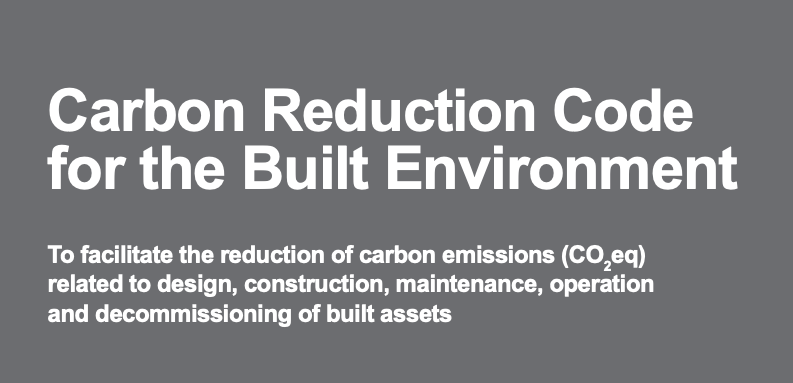
Submitted by L. Millard on Mon, 01/11/2021 - 11:57
Today, Monday 1 November 2021, as COP26 brings together nations and representatives to secure the world-wide solidarity needed to make the required commitment to address climate change, marks the launch of the sign-up process to the Carbon Reduction Code for the Built Environment that offers organisations a collaborative and supportive approach to reducing carbon.
The Carbon Reduction Code for the Built Environment, which forms part of the Construction Leadership Council’s Co2nstruct Zero programme, was published by CSIC in June this year to provide a mechanism that enables individual organisations to publicise their annual progress, and thereby collaborate and share best practice on their journey to Net Zero with the intention of accelerating progress across the industry.
Following early trials by the National Association of Construction Frameworks (NACF), the Environment Agency, and Skanska Costain STRABG and HS2 Joint Venture, the Code has been reissued (Carbon Reduction Code for the Built Environment Issue 2021:2) to reflect industry feedback and is now published on the CSIC website along with the sign-up process.
Who is the Code for?
The Code is designed for clients, contractors, and supply chain members working in the built environment. In order to enable wide participation, organisations may join at a global, national or regional level as well as at a major project level. While the Code’s reporting mechanism provides a point of difference, it is designed to work alongside a number of excellent existing initiatives including the ICE Carbon Project, Construction Innovation Hub Procuring for Value framework and toolkit, Infrastructure Carbon Review Seven Years On report, and RICS Building Carbon Database.
What do organisations need to do to comply with the Code?
The Code offers three levels of commitment:
- Core commitments for all organisations
- Core commitments for client organisations and further commitments to facilitate the transition to Net Zero
- Core commitments for supply chain organisations and further commitments to facilitate the transition to Net Zero.
All organisations must be in accordance with the minimum entry level of compliance to attain Pledger status. This means agreeing to the core commitments of setting out plans to meet net zero by 2045, including annual targets, and publishing these and the progress made against them every year. Pledger levels also requires setting an interim target to reduce net direct and indirect carbon emissions for 2030, which aligns with or exceeds government strategy. Signatory level requires signing up to additional core commitments relevant to the organisation – be it client or supply chain, and Champion level sees commitments to more ambitious collaborative progress.
How do organisations sign-up to the Code?
The sign-up form for the Code can be completed on the CSIC website. The sign-up form is accompanied by an Excel spreadsheet listing all the information required to make the sign-up process easy to complete. There is no cost to signing-up to the Code.
Dr Jennifer Schooling OBE, Director of CSIC, said: “The Code recognises that we must start making meaningful change, and we have to start making it today. Not tomorrow, not next week and certainly not next year. I urge you to visit the CSIC website to read the Code to understand what is required and sign-up. By working together towards a greater good we all make progress.
“Collaboration and commitment will be key to success, and with alignment of ambition across all parties we can progress towards net zero carbon at the pace required. The Code provides an encouraging, supportive and collaborative approach to reducing carbon. It is essential that our industry reduces carbon emissions and the more organisations that sign up to the Code, the more we will achieve.
Quick links
Read the Carbon Reduction Code for the Built Environment Issue 2021:2 here
Read full compliance information for the Code here
Sign up to the Code here
Read about the development of the Code and watch a short video of the launch event for the Code here
Read the Smart Infrastructure Blog by CSIC Programme Manager Dee Dee Frawley that calls for built environment organisations to sign-up to the code here
Note for Editors
The Code was drafted by the CSIC Achieving Net Zero Cross-Industry Working Group in 2020 and first issued in 2021. The Working Group comprises more than 40 representatives from a diverse range of consultants, contractors, industry groups and local and central government, including: Department for Business, Energy & Industrial Strategy; Infrastructure and Projects Authority; Environment Agency; Highways England; Skanska UK; and the National Association of Construction Frameworks (NACF). It is expected that it will be updated as carbon targets change and progress towards Net Zero carbon is achieved.
Read about the early Carbon Reduction Code for the Built Environment case studies:
• NACF Carbon Reduction Code Trial Case Study
• Environment Agency Carbon Reduction Code Trial Case Study
• Skanska Costain STRABG Joint Venture (SCSJV) / HS2 Code Trial Case Study
